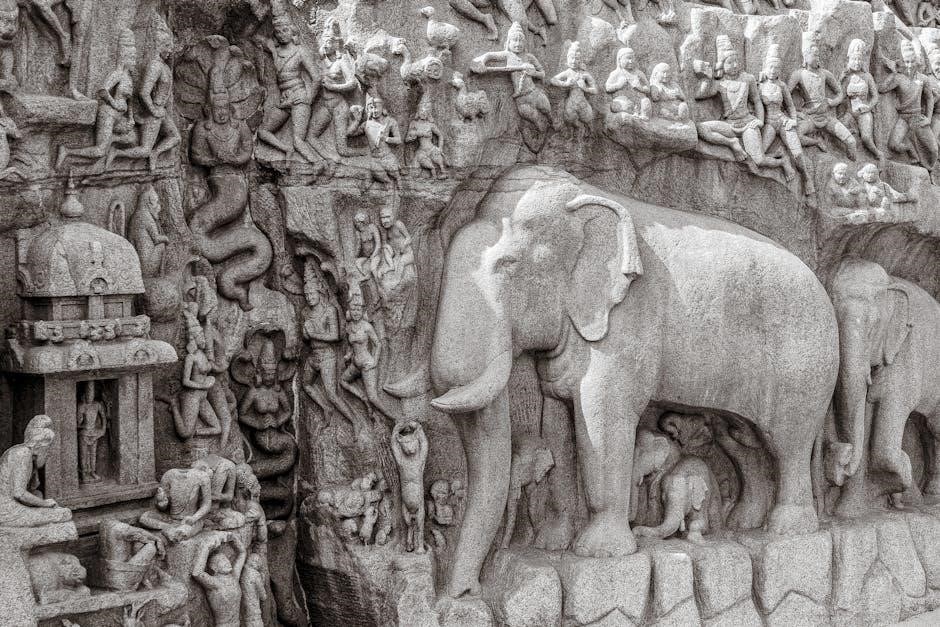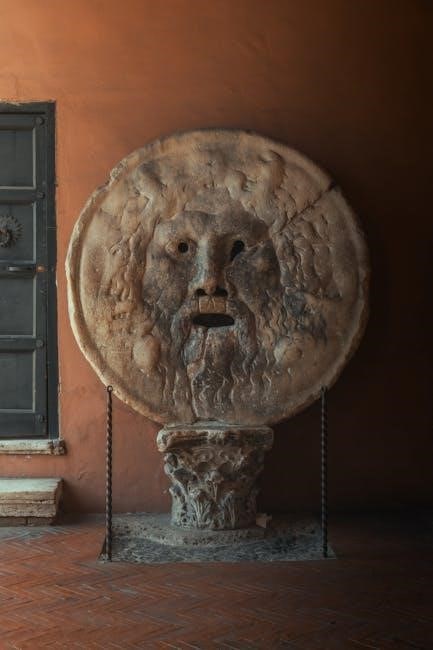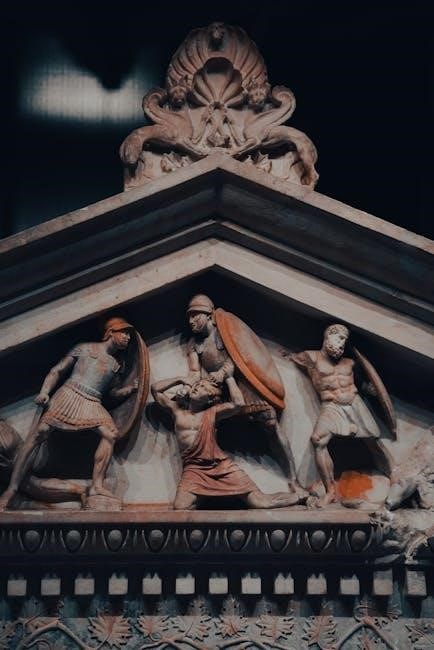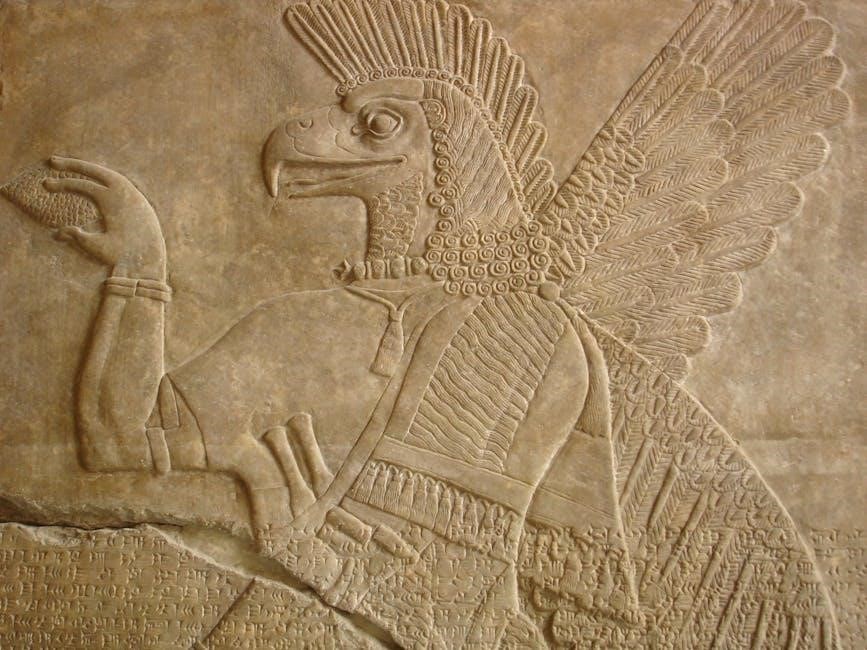Karen Armstrong’s A Short History of Myth explores the significance of myth in human culture, tracing its evolution and enduring relevance across civilizations and time.
Overview of Karen Armstrong’s Work
Karen Armstrong, a renowned scholar of religion and mythology, has authored numerous influential books that explore the intersection of faith, history, and culture. In A Short History of Myth, she delves into the universal human impulse to create stories that give meaning to life, tracing the evolution of myth from ancient times to the present. Armstrong’s work is characterized by her ability to synthesize complex ideas into accessible narratives, making her a respected voice in both academic and popular circles. This book, part of the Canongate Myth Series, examines how myths have shaped human identity, morality, and spirituality, emphasizing their enduring relevance in understanding our shared cultural heritage.
The Importance of Myth in Human Culture
Myth has served as a cornerstone of human culture, providing a framework for understanding the world and our place within it. Armstrong emphasizes that myths are not merely fictional tales but profound expressions of collective wisdom. They address fundamental questions about existence, morality, and the unknown, offering insights that transcend historical contexts. Myths have shaped art, religion, and philosophy, influencing how societies construct meaning and identity. By exploring the symbolic language of myths, Armstrong illustrates their role in connecting the human experience across generations, highlighting their enduring relevance in modern times. This perspective underscores the importance of preserving and interpreting myths as vital components of our cultural legacy.
Structure of the Book
A Short History of Myth by Karen Armstrong is structured to trace the development of mythological narratives from prehistoric times to the modern era. The book is divided into thematic sections, each exploring how myths have evolved to reflect the changing needs and understanding of human societies. Armstrong examines the role of myths in addressing existential questions, explaining natural phenomena, and providing moral guidance. She also delves into the intersection of myth and history, particularly during the Axial Age, which marked a significant shift in human thought and spirituality. The narrative flows chronologically, from ancient myths to contemporary reinterpretations, offering a comprehensive overview of the subject while maintaining a clear and engaging structure.

Publishing Details and Availability
A Short History of Myth by Karen Armstrong was published in 2005 by Canongate Books. It is available in hardcover, paperback, Kindle, and PDF formats.
Editions and Formats (Hardcover, Paperback, Kindle, PDF)
A Short History of Myth by Karen Armstrong is available in multiple formats to suit reader preferences. The book can be purchased as a hardcover or paperback, offering a tactile reading experience. For digital readers, it is accessible on Kindle, enabling portability and convenience. Additionally, a PDF version is widely available for download from platforms like Z-Library, Perlego, and Scribd, making it easily accessible for academic and casual readers alike. The PDF format ensures compatibility across devices, preserving the book’s original layout and readability. With these diverse options, readers can engage with Armstrong’s insightful exploration of myth in a format that best fits their needs and preferences.
Publisher and Publication Date
A Short History of Myth was published by Canongate Books Ltd., a renowned publishing house. The book was first released in 2005 as part of the Canongate Myth Series, which aimed to reinterpret classic myths for modern audiences. It later gained widespread availability in 2006, further cementing its place in literary discussions. The publication marked an important contribution to the study of mythology, showcasing Armstrong’s ability to weave historical and cultural insights into a compelling narrative. This edition has since become a cornerstone in the exploration of mythological themes, resonating with scholars and general readers alike.

Where to Download or Purchase the Book
A Short History of Myth by Karen Armstrong can be purchased or downloaded from various platforms. Amazon offers the book in paperback, hardcover, and Kindle formats, making it easily accessible to readers worldwide. Additionally, digital versions are available on platforms like Z-Library and Scribd, where users can download the book in PDF or EPUB formats. Perlego also provides access to the book as part of its extensive library. For those preferring e-books, platforms like Kindle and Google Books offer convenient download options. With its wide availability across multiple platforms, readers can easily acquire and engage with Armstrong’s insightful exploration of mythology.
Online Platforms Offering the Book (Z-Library, Perlego, Scribd)
Karen Armstrong’s A Short History of Myth is widely available on popular online platforms. Z-Library offers the book as a free PDF download, with a file size of 502 KB, making it easily accessible to readers worldwide. Perlego provides the book as part of its subscription service, allowing users to read it online or download it via their app. Additionally, Scribd offers the book for free download in PDF format, catering to users who prefer digital reading. These platforms ensure that readers can conveniently access Armstrong’s work, whether through subscription-based services or free downloads, making her insights on mythology readily available to a global audience.

The Evolution of Myth
Karen Armstrong explores how myths transform over time, influenced by cultural shifts and societal needs, adapting to new contexts while retaining core themes and meanings.
Early Myths and Their Significance
Early myths emerged as humanity sought to explain the mysteries of existence, death, and the natural world. These stories, often tied to burial practices and spiritual beliefs, reflected a deep desire to connect with the unknown. Armstrong highlights that myths were not merely entertainment but served as a way to impose meaning on the chaos of life. Early myths also addressed fundamental questions about human identity and the cosmos, laying the groundwork for cultural and religious systems. By examining these narratives, Armstrong reveals how they provided moral guidance and helped societies understand their place in the world. This section underscores the foundational role of myth in shaping human consciousness and culture from the earliest times.
Mythology as a Reflection of Human Society
Mythology serves as a mirror of human society, reflecting its values, fears, and aspirations throughout history. Karen Armstrong illustrates how myths have consistently echoed the social structures and cultural norms of their times. From the hierarchical pantheons of ancient civilizations to the egalitarian ideals of modern narratives, myths have evolved alongside human societies. Armstrong emphasizes that mythology is not static; it adapts to societal changes, offering insights into collective consciousness. By examining these stories, we gain a deeper understanding of how human societies have grappled with identity, morality, and the divine. This dynamic interplay between myth and society highlights the enduring relevance of mythology in shaping cultural and ethical frameworks.
Changes in Mythological Narratives Over Time
Karen Armstrong explores how mythological narratives have evolved over time, reflecting changing human needs and understanding. Early myths often revolved around natural phenomena and the divine, while later narratives incorporated moral and ethical teachings. The transition from polytheistic to monotheistic traditions, for instance, reshaped mythological themes, emphasizing a single, unifying deity. Armstrong highlights that myths are not static but adapt to societal shifts, such as the rise of rationalism and science, which challenged traditional mythological explanations. Despite these changes, the core function of myths—to provide meaning and explain the unknown—has remained consistent. This dynamic evolution ensures that mythology remains relevant, continuing to inspire and guide humanity in new cultural and historical contexts.
The Role of Myth in Human Society
Myths serve as a cornerstone of human culture, providing explanations for life’s mysteries, fostering moral guidance, and uniting societies through shared beliefs and stories.
Myth as a Tool for Explaining the Unknown
Myths have long served as a fundamental human endeavor to make sense of the mysteries of existence. By creating stories that explore the unknown, myths provide explanations for natural phenomena, the origins of life, and the workings of the universe. Early societies used myths to comprehend the unexplainable, such as the cycles of nature or the forces of fate. These narratives were not merely entertainment but a way to impose order on chaos. Armstrong emphasizes that myths are not factual histories but symbolic expressions of human experiences. They function as a bridge between the tangible world and the ineffable, offering meaning and purpose. Through myths, cultures have been able to articulate the inexplicable and find comfort in shared understanding.
Mythology and Spirituality
Mythology has always been deeply intertwined with spirituality, serving as a bridge between the human and the divine. Myths often express the sacred and the mysterious, providing a framework for understanding existential questions. Armstrong highlights how myths explore themes of transcendence, the unknown, and the ultimate meaning of life. They are not just stories but a way to connect with the ineffable, offering insights into the human condition. Through rituals and narratives, myths help individuals experience the sacred and find spiritual fulfillment. Armstrong emphasizes that mythology is not about literal truth but about evoking a sense of awe and wonder, which are central to spiritual experiences. Myths, in this sense, are a powerful tool for exploring the depths of human spirituality and the search for meaning.
Myth as a Source of Moral and Ethical Guidance
Myths have long served as a moral compass, offering insights into right and wrong through timeless stories. Armstrong explains how myths provide ethical lessons, shaping cultural values and guiding human behavior. They often feature heroes and villains, illustrating moral dilemmas and the consequences of choices. Myths also convey universal truths about justice, compassion, and responsibility, transcending time and culture. Armstrong notes that these stories help individuals navigate complex moral landscapes, fostering empathy and self-reflection. By embedding moral teachings within narratives, myths make ethical principles relatable and memorable. This enduring role of myth in moral guidance highlights its continued relevance in shaping individual and societal ethics today.

Key Themes in “A Short History of Myth”
Karen Armstrong explores the evolution of myth, examining themes like the concept of God, life-death-rebirth cycles, and the interplay between myth and history, revealing their cultural significance.
The Concept of God and Its Evolution
Karen Armstrong examines how the concept of God has evolved through myths, highlighting its exploitation and abuse, such as the myth of a chosen people. She emphasizes that myth is not merely a primitive attempt at history but a profound exploration of the unknown, revealing the human quest for meaning. Armstrong underscores that myth, like a novel or opera, is a creative expression of existential truths. The book, available as a PDF on platforms like Z-Library, explores how myths about God reflect human societies’ values and fears, illustrating the dynamic interplay between theology and culture. Armstrong’s analysis reveals the enduring relevance of myth in understanding the divine and human existence, making it a vital read for those interested in the evolution of religious thought.
The Cycle of Life, Death, and Rebirth
Karen Armstrong delves into the universal theme of life, death, and rebirth, a cycle mirrored in nature and human existence. Myths often use seasonal imagery, such as harvests and renewal, to explain these transitions. Armstrong highlights how stories of gods dying and being reborn reflect humanity’s attempt to understand mortality and the afterlife. This cycle, central to many mythologies, symbolizes transformation and the eternal nature of life. Armstrong’s exploration reveals how this theme continues to resonate, offering insight into the human condition and our enduring quest for meaning. The book, available as a PDF, underscores the timelessness of these narratives in shaping cultural and spiritual understanding. Armstrong’s analysis bridges ancient myths with contemporary relevance, enriching our grasp of existential truths.
The Relationship Between Myth and History
Karen Armstrong examines the intricate relationship between myth and history, arguing that myths are not historical accounts but stories that convey deeper truths. While history seeks to document past events, myths explore the human condition through symbolic narratives. Armstrong emphasizes that myths were never intended to be factual records but rather to provide meaning and purpose. Over time, myths have often intertwined with historical events, blurring the line between the two. Armstrong argues that understanding this distinction is crucial, as myths reveal universal truths about existence, while history focuses on specific events. This interplay highlights the complementary roles of myth and history in shaping human understanding. Armstrong’s insights, available in PDF, offer a profound exploration of how myths and history coexist and influence one another.
The Axial Age and Its Impact on Mythology
Karen Armstrong highlights the Axial Age (c. 800–200 BCE) as a pivotal era that transformed mythology worldwide. During this period, thinkers like Buddha, Socrates, and Isaiah redefined myth, shifting its focus from cosmic narratives to ethical and spiritual truths. Armstrong argues that myths began to emphasize compassion, justice, and transcendence, reflecting a universal human quest for meaning. This era marked a transition from myths explaining natural phenomena to those addressing inner human experiences. Armstrong’s analysis, available in PDF, reveals how Axial Age ideas reshaped mythology, creating a legacy that continues to influence contemporary thought and spirituality. This shift underscores the enduring adaptability of myth in addressing human existential questions. Armstrong’s work provides a compelling exploration of this transformative period.
Modern Relevance of Myth
Myths remain vital in the 21st century, influencing literature, media, and cultural identity, as explored in Karen Armstrong’s work, showing their enduring power to shape human understanding.

Why Myths Still Matter in the 21st Century
Myths remain deeply relevant today, offering insights into human nature, culture, and existential questions. In Karen Armstrong’s work, she highlights how myths continue to inspire modern literature, art, and psychology, serving as a bridge between past and present. They provide moral guidance, explain universal mysteries, and foster empathy, making them timeless. Armstrong emphasizes that myths are not static but evolve, adapting to contemporary challenges and technological advancements. Their enduring appeal lies in their ability to connect us to our collective heritage while addressing modern dilemmas, ensuring their continued influence in shaping cultural identity and personal understanding. Thus, myths are not relics of the past but living narratives that resonate across generations.
Mythology in Contemporary Literature and Media

Mythology’s influence is evident in modern literature and media, where ancient stories are reimagined to resonate with contemporary audiences. Authors like Margaret Atwood and Jeanette Winterson contribute to the Canongate Myth Series, revisiting classic myths. These reinterpretations breathe new life into timeless narratives, exploring themes like identity, morality, and human condition. In media, myths inspire films, TV shows, and video games, showcasing their enduring appeal. Karen Armstrong’s work highlights how these adaptations ensure myths remain relevant, bridging the gap between tradition and innovation. By integrating mythological elements, creators tap into a universal cultural heritage, making ancient stories accessible and meaningful in today’s world, thus preserving their significance for future generations.
The Role of Myth in Shaping Cultural Identity
Myths have long served as a cornerstone of cultural identity, providing societies with shared narratives that define their values, beliefs, and history. As explored in Karen Armstrong’s A Short History of Myth, these stories often reflect a community’s collective experiences and aspirations. Myths create a sense of belonging by encoding cultural norms and traditions, while also addressing existential questions. Armstrong emphasizes that myths are not static; they evolve alongside societies, adapting to new challenges and perspectives. This dynamic quality ensures that myths remain central to a culture’s identity, offering a bridge between past and present. By preserving and reinterpreting these narratives, cultures maintain their uniqueness while fostering understanding across generations. Thus, myths continue to be a vital source of identity and unity in an ever-changing world;
Reception and Reviews
A Short History of Myth has received widespread acclaim for its insightful exploration of mythology. Readers praise its clarity, while scholars appreciate its depth and original perspective.

Critical Acclaim and Scholarly Responses
Karen Armstrong’s A Short History of Myth has garnered significant scholarly attention for its profound analysis of mythology’s role in shaping human culture. Academics praise the book for its accessible yet deeply insightful exploration of mythological themes, bridging the gap between academic rigor and general readership. Armstrong’s ability to trace the evolution of myth from ancient times to modernity has been particularly commended. Many scholars highlight her unique perspective on the Axial Age and its impact on mythological narratives. While some critics note that the book does not introduce entirely new theories, they acknowledge its value in synthesizing existing knowledge into a cohesive and engaging narrative. The work is widely regarded as a essential contribution to the study of mythology, offering fresh perspectives on timeless themes. Its intellectual depth and clarity have solidified its place in both academic and popular discussions of myth.
Reader Feedback and Ratings
Readers have responded enthusiastically to Karen Armstrong’s A Short History of Myth, with many praising its clarity and depth. The book holds a high average rating on platforms like Amazon and Goodreads, where reviewers often describe it as thought-provoking and accessible. Many readers appreciate how Armstrong connects mythological themes to contemporary issues, making the subject relevant to modern audiences. Some have noted that the book serves as an excellent introduction to mythology for those new to the topic, while others highlight its ability to inspire deeper exploration. The PDF version, available on platforms like Z-Library and Scribd, has been particularly popular for its convenience. Overall, the book has resonated with a wide audience, sparking discussions and reflection on the enduring power of myth in human culture.
Comparisons with Other Works by Karen Armstrong
Karen Armstrong’s A Short History of Myth is often compared to her other works, which explore themes of religion, history, and human culture. While books like The Battle for God and The History of God delve into specific religious traditions, A Short History of Myth offers a broader perspective on mythology’s universal role. Readers familiar with Armstrong’s writing appreciate her consistent ability to weave together historical and cultural insights, making complex ideas accessible. This book, however, stands out for its concise yet comprehensive approach, making it a gateway to her more detailed studies. The PDF version, widely available online, has been praised for its readability and portability, allowing readers to engage with Armstrong’s thought-provoking analysis on the go. Fans of her work often note that this book encapsulates her signature blend of scholarship and storytelling.
A Short History of Myth by Karen Armstrong is a profound exploration of myth’s enduring role in human culture, available as a PDF for easy access, revealing its timeless relevance.
The Enduring Legacy of Myth
Myth, as explored by Karen Armstrong, remains a vital part of human culture, offering insights into our deepest beliefs and existential questions. Armstrong emphasizes that myths are not primitive explanations of the world but rather a way to express the inexpressible, providing meaning and purpose. The legacy of myth lies in its ability to transcend time, adapting to societal changes while maintaining its core function of connecting humanity to the unknown. Armstrong’s A Short History of Myth, available as a PDF, highlights how myths have shaped moral, spiritual, and cultural identities, ensuring their relevance even in modern times. This legacy underscores the enduring power of storytelling in understanding ourselves and the world around us.
Karen Armstrong’s Contribution to the Study of Mythology
Karen Armstrong’s work, particularly A Short History of Myth, has significantly enriched the study of mythology by providing a comprehensive and accessible exploration of myths across cultures and time. Armstrong’s unique approach blends historical analysis with philosophical insights, making complex mythological concepts understandable to a broad audience. Her emphasis on the universal themes of myths, such as the cycle of life, death, and rebirth, highlights their enduring relevance. The book, available as a PDF, not only educates but also inspires readers to reflect on the role of myths in shaping human identity and spirituality. Armstrong’s contribution lies in her ability to bridge academia with popular understanding, ensuring that mythology remains a vital field of study in modern times.
Final Thoughts on the Book’s Impact
A Short History of Myth by Karen Armstrong has left a lasting impact on readers and scholars alike, offering a profound exploration of mythology’s role in human culture. The book’s concise yet insightful narrative bridges the gap between ancient myths and modern understanding, making it accessible to a wide audience. Armstrong’s ability to weave together diverse mythological traditions highlights their universal themes, such as the cycle of life, death, and rebirth. The PDF format has further expanded its reach, allowing readers to engage with her ideas digitally. Ultimately, the book inspires reflection on the enduring power of myths to shape our identities and understanding of the world, ensuring its relevance for future generations. Armstrong’s work remains a vital resource for anyone exploring the significance of mythology in both historical and contemporary contexts.